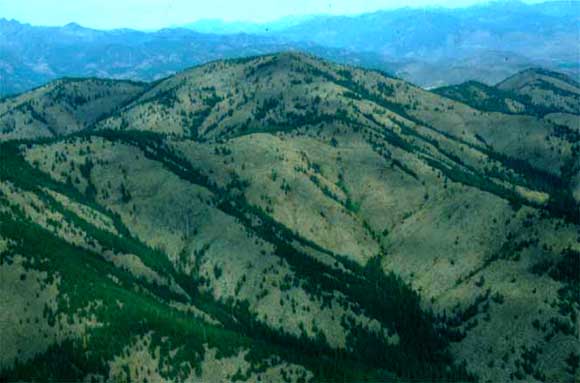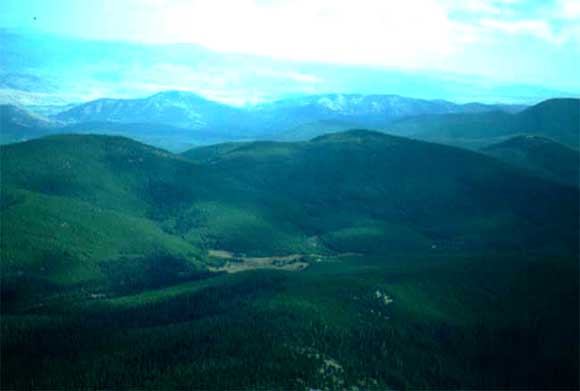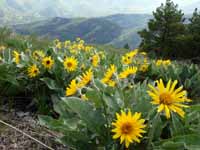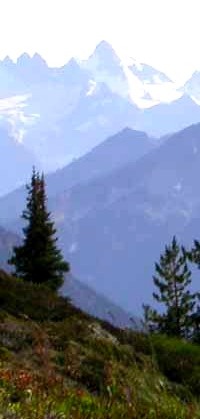Questions and Answers About Uninventoried Roadless Areas
(written by Peter Morrison, Pacific Biodiversity Institute in 1999)
What are uninventoried National Forest roadless areas?
Uninventoried roadless areas are wildlands on National Forest land that do not contain roads or other developments but were never inventoried by the US Forest Service during their several attempts to map and inventory roadless areas in the last 30 years.
Why do uninventoried roadless areas exist?
This is a good question. The US Forest Service failed to include these areas in their successive set of inventories of roadless areas beginning with RARE I. In most cases it appears that they just overlooked these areas. The Forest Service did not employ a rigorous, consistent and comprehensive method in their roadless area inventories. This could easily explain why some areas were missed. But in other cases, where the areas are large and well known, it is hard to come up with a satisfactory explanation for why these areas were ignored.
Are there any differences between uninventoried roadless areas and those inventoried by the Forest Service?
Uninventoried roadless areas have the same wilderness characteristics as inventoried roadless areas. They meet all the same criteria for consideration as designated Wilderness as the inventoried areas. In many cases, they comprise lower elevation landscapes and contain rare and unusual habitats that do not exist in the inventoried areas or in designated Wilderness. From a biological and ecological perspective, these areas often have equal or greater conservation value as the inventoried areas. They are also important areas for human enjoyment and recreation.
Is there more than one type of uninventoried roadless area?
Yes, there are three types of uninventoried roadless areas. The first type is the non-contiguous uninventoried roadless area. These areas are distinct roadless areas that are separated from other wildlands by a stretch of roaded landscape or at least one dividing road. They are over 5000 acres in size and qualify for consideration as a distinct Wilderness Area under the 1964 Wilderness Act.
The second type is the contiguous uninventoried roadless area. These are areas that are contiguous with inventoried roadless areas or designated Wilderness (or both). They are the natural and correct extensions of these wildlands. These areas represent areas that were not inventoried by the Forest Service, but should have been included in their inventoried areas. These areas also meet all the requirements for consideration as Wilderness under the 1964 Wilderness Act. These areas exist because the Forest Service was very inconsistent and often sloppy when it drew the boundaries of the inventoried roadless areas. Since they are contiguous with inventoried roadless areas or Wilderness, their size is unimportant. Some of these areas exceed 20,000 acres while others are less than 100 acres. They are all part of a wild area that is over 5000 acres in size and should be considered for Wilderness designation in its entirety.
A third type of uninventoried roadless area is an area that is over 1000 acres but less than 5000 acres. The Forest Service did not inventory these areas because they were not considered to be suitable for inclusion as Wilderness under the terms of the 1964 Wilderness Act. Their exclusion from the Forest Service inventory was intentional. Normally, we restrict the term "uninventoried roadless area" to areas that are over 5000 acres or contiguous to areas over 5000 acres.
Two Examples of uninventoried roadless areas
While there are many uninventoried roadless areas in the country, two examples will convey some of the characteristics and issues related to these areas. Both examples are taken from the Okanogan National Forest in eastern Washington.
Lookout Mountain Roadless Area

The Lookout Mountain roadless area lies immediately southwest of Twisp, Washington and is visible from most of the Methow Valley. It is a non-contiguous roadless area of 12,344 acres. This area is dominated by ponderosa pine and Douglas-fir forests and slopes covered with shrub-steppe vegetation. Many of the forests in this area have old-growth characteristics. It contains some of the best remaining intact examples of low elevation forests in eastern Washington. It is actually connected to the McClure Mountain roadless area (another uninventoried roadless area of 5941 acres to the east of Lookout Mountain) by a narrow roadless corridor. Together these two areas comprise over 18,000 acres of uninventoried wild land and are larger that many designated Wilderness Areas. Perhaps they were overlooked because they were too close to the Forest Service Ranger Station in Twisp, Washington. We all have a tendency to overlook things that are right in front of our noses.
Granite Mountain Roadless Area

The Granite Mountain roadless area is an officially inventoried roadless area, but about half of the area eluded the skilled Forest Service employees who were conducting the inventory. This area is a large wild landscape, which ranges from subalpine forests and meadows down through low elevation ponderosa pine forests and slopes covered with shrub-steppe vegetation. This area contains extensive lynx, wolf and grizzly bear habitat. It also forms the headwaters for many streams that flow into spawning areas for steel head, bull trout and spring Chinook salmon - all species listed under the Endangered species act. The entire Granite Mountain roadless area is nearly 54,600 acres, but the inventoried portion is only about 27,700 acres. The uninventoried parts of this area are just as wild as the inventoried portion. The Forest Service decided in 1988 to divide this area into two separate units despite the fact that a wild and undisturbed corridor over a mile in width connects the two units. The uninventoried portions of this area contain extensive mature and old-growth forests with relatively high timber volumes. Some have thought that is might be one reason that about 27,000 acres eluded the trained eyes of the Forest Service employees conducting the inventory.
Why are these areas excluded from the Forest Service road building moratorium?
This is also a good question. If there are good reasons for implementing the Forest Service road building moratorium, then it should apply to these areas. These areas have all the same attributes as the inventoried roadless areas where the moratorium applies. They have all the same environmental constraints and strong ecological reasons for protection of their biological resources. If building roads in inventoried roadless areas is a bad idea, then it’s an equally bad idea in the uninventoried roadless areas. The only reason that these areas haven't gotten the protection that they deserve is that a lazy government employee forgot to put them on a list.
What is the magnitude of the uninventoried roadless area problem?
The scope of the uninventoried roadless area issue is large. Pacific Biodiversity Institute's recent study of roadless areas in Washington State (Morrison and others 1998) revealed that over 860,000 acres of uninventoried roadless land still exist in National Forests of the state. We have good indications that similar amounts exist in other western states. On some National Forests only about half of the areas that should have been included in the official list of inventoried areas actually got included. This is a big problem that the Forest Service continues to ignore.
What can be done about this problem?
A comprehensive, consistent and accurate inventory of roadless areas is not a difficult task. Pacific Biodiversity Institute has developed a scientifically rigorous method of mapping and inventorying undeveloped and roadless lands. We have already finished this task for Washington, Oregon and parts of California. All roadless areas - inventoried or uninventoried - should be included in the Forest Service roadless area protection plans. These are often some of the most biologically significant areas. Write the US Forest Service and ask them to include all uninventoried roadless areas in the Environmental Impact Statement that they are preparing.
Where can I learn more about uninventoried roadless areas?
In 1998 Pacific Biodiversity Institute published the first of a series of papers describing these areas, Unprotected Wildlands in Washington State (PDF) (Morrison and others 1998). This publication describes a rigorous methodology for wildland inventory and assessment. It describes the current status of wildlands in Washington State. It also discusses the problem of uninventoried roadless areas in considerable detail showing maps of these areas on each national forest in Washington State.
Copyright © Pacific Biodiversity Institute
PO Box 298, 517 Lufkin Lane
Winthrop, WA 98862 509-996-2490
 Marine Mammals
Marine Mammals
